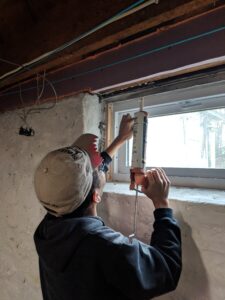
This post is part of our ongoing series about the Inflation Reduction Act. For more information, see our previous posts: Funding Our Energy Transition; Get Ready Today; and Heat Pumps.
The Inflation Reduction Act (IRA) is the largest piece of climate legislation in US history, and it has the potential to have enormous impacts on energy costs, pollution, and climate change across the country. Through this huge investment, the federal government will be providing funding to energy efficiency projects and programs. There will also be energy efficiency funding available from the Minnesota state government in coming years. The funding that will be provided is mainly aimed at reducing the costs of home energy efficiency upgrades.
Making a home energy efficient is a complex multi-step process. This post is about weatherization.

Weatherization is the process of preparing our homes for all types of weather, from snowstorms to heat waves. It will make your home more comfortable, lower your energy bills, and (if done properly) improve your indoor air quality. Weatherization should be completed before you invest in new appliances, windows, or solar panels.
Weatherization has three main aspects: insulation, air sealing, and ventilation.
Insulation is all about keeping heat in as long as possible. Like a cozy sweater, insulation traps the heat in the house. Temporary projects, like plastic window wrap kits or even rugs, add a bit of insulation. For long term projects, one of the best places to start is in the attic. Insulating your attic is like wearing a good warm hat. The basement is another area that tends to be under-insulated in many homes.
Air sealing makes your home more airtight. Reducing air loss makes it easier to maintain a comfortable temperature. Some simple versions of this include using draft stoppers underneath doors or adding weather stripping to windows. You can also improve your home’s air sealing by re-caulking around windows, fixing gaps in walls, and sealing off the entrance to the attic. When you’re ready for larger projects, you may also check the ceiling of your attic, and cracks and joints in your foundation. If insulation is like a cozy sweater, proper air sealing is like a windproof shell on your winter coat.
Ventilation is the process of bringing fresh, healthy air into a room or house. Many of us improve our indoor air quality by using portable filters, especially in the winter when windows are closed. But this isn’t quite enough if you’ve improved your insulation and air sealing. Air sealing without updating ventilation can trap moisture in your home and lead to mold or mildew issues. It can also trap harmful fumes in your home, for example from a gas furnace. But with a thoughtful ventilation plan, you can avoid those problems and even improve your indoor air quality!
Weatherization can be a long, complex process, because along the way you might find more projects that need doing. You may need to remove hazardous materials or update your ventilation system. An energy auditor can help you make a plan for the entire process.
There are also local, state, and federal resources to support you in the weatherization process. IRA tax credit and rebate programs, as well as state-level programs, are being created to reduce costs. These programs will support weatherization, updating appliances, and many other steps of home energy efficiency. For income eligible homes, the Weatherization Assistance Program (WAP) is a well-established resource for making your home more comfortable and efficient. Your local community action agency will start with an energy audit, develop a scope of work, and perform improvements on the home.
We want to be a resource to help you through your home energy journey, and we happen to know a lot about weatherization! We offer some weatherization services in-house, or we can provide you with the information you need to properly weatherize your home yourself or with the help of a contractor. It all starts with an energy audit. Sign up for your energy audit today!